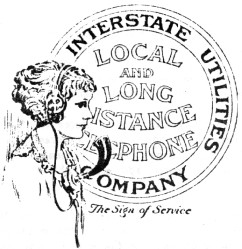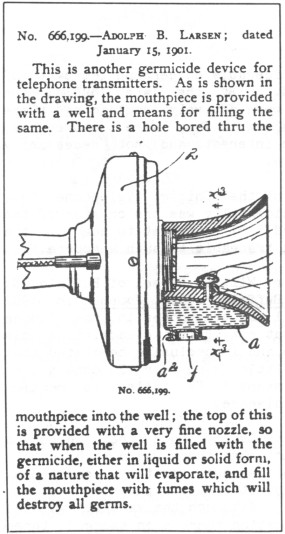Microbes And Mouthpieces
by Vic Sumner
Reprinted from "Crown Jewels of the Wire", May 1986, page 42
In this high tech world of today we are witness to an endless array of
scientific discoveries. Even in the biological world are we finding new and/or
altered diseases. Society and governments are up in arms over such afflictions
as Legionnaires disease, Herpes and AIDs.
Although we knew nothing of these diseases in my time, we did have our share
and then some. We tend to forget or disregard those afflictions now seldom heard
of such as Polio, the Plague, Diphtheria, Smallpox, Quinsy, etc. These were very
real and, in many cases, perhaps more dreaded than the diseases of today.
Because there were no miracle drugs the routine problems of today often meant
death to turn of the century victims.

No sooner had the telephone been demonstrated in 1876 than folks began
wondering if the cup-like opening, that we knew as the "transmitter
cap," might not be a breeding ground for disease. Early users of the
telephone were urged to hold their lips no further than two inches from the
opening while speaking. Thus the user could, it was theorized, impart mouth-born
bacteria into the transmitter where it was to find suitable conditions for
multiplying. It was further surmised that the next user could be infected.
All this caused considerable concern on the part of the parties involved. By
the late 1890's the telephone companies were actively proclaiming there was no
cause for alarm. They were, of course, protecting their own interests and not
necessarily that of their customers.
In 1901 the manager of the Chicago Telephone Co., Angus Hibbard, who
incidentally was the creator of the Bell logo, proclaimed, "I have yet to
hear of the first case of sickness traceable to such a source."
Another "authority," Dr. William Bissel of Buffalo, N. Y., reported
in the Buffalo Medical Journal in 1902 that he had tested all the telephones in
the "three largest hotels in that city." While admitting his tests
were incomplete and inconclusive he stated that it "appears there is little
or no fear of contracting Diphtheria by this means." He failed to mention
researching any other disease.
Despite all the denials by both the telephone companies and manufacturers
there was a rush on to develop a method to assure sanitary conditions. Literally
dozens of inventions were patented between 1895 and the 1920's. Although the
variety was as endless as man's imagination there soon emerged three prominent
conceptions. One was to produce a sanitary climate within the transmitter via
chemical action (see illustration). Another was to place some object over the
entrance to the transmitter that would filter the "noxious germs." The
third often used concept was to construct the transmitter cap of a material that
either could not act as a host to germs or one that was easily cleaned. This
last idea became widely adopted due to its simplicity.

Large Image (115 Kb)
All manner of materials were tried, i.e. wood, a hard rubber, porcelain, ivory, brass, etc., but in the end glass was generally
accepted as the most nearly perfect substance. By the advent of World War I and
it's accompanying killer influenza epidemic, a very clever glass cap had
appeared. Made of crystal, it was so designed that it would fit into an existing
mouthpiece and could, if the owner wished, be removed at the end of his
conversation and carried in his pocket until again needed. Being portable, it
could be easily sanitized with alcohol or by boiling in water.
Whether any methods were effective or indeed whether there was ever a real reason to be concerned escapes
this writer, but many felt there was a very real danger. For instance, the
Telephone Hygienic Company was incorporated in Los Angeles during 1900 for the
purpose of manufacturing sanitary appliances for telephones. In many telephone
companies it was a common practice for repairmen to routinely remove the
transmitter cap from any set he worked on and throw it away. Because the caps
were just three to six cents each we felt the cost was justified. A small price
for peace of mind.
MA
ALL RIGHTS RESERVED
For comments or suggestions, contact
Vic Sumner, 12608 Browning Court, Grand Terrace, California 92324. Telephone
714-783-1824.
| 